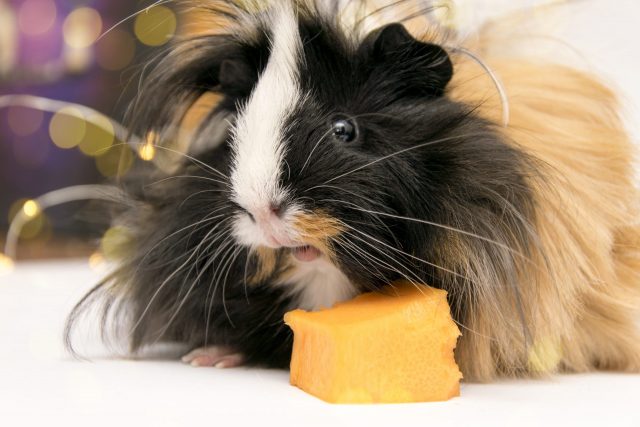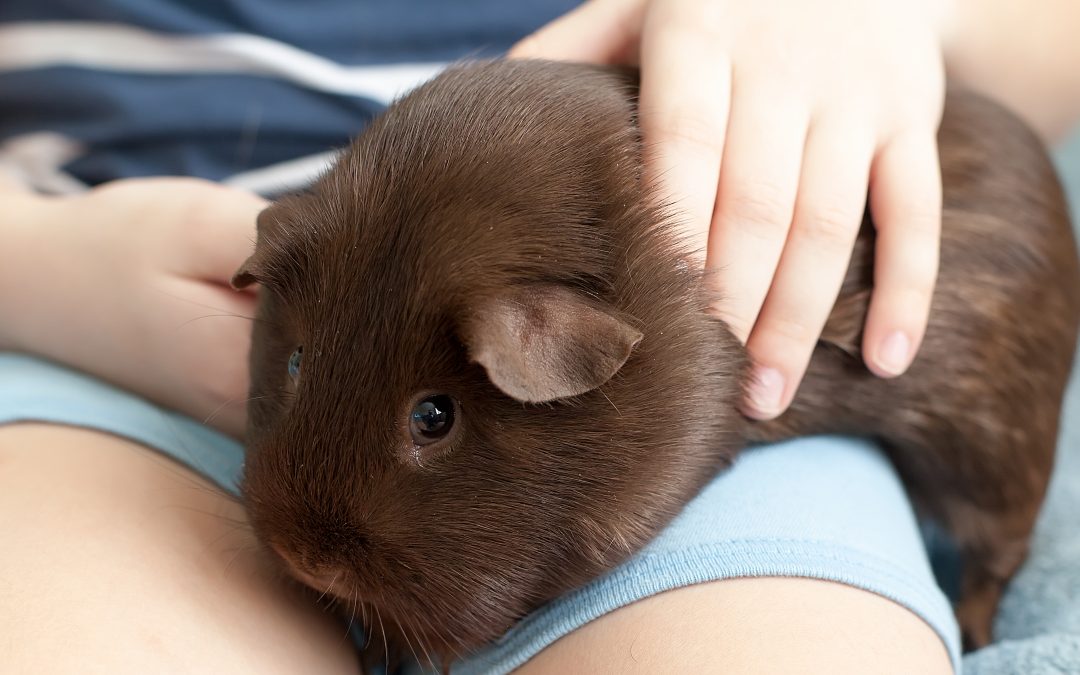With their chubby cheeks and sometimes wild hair, guinea pigs are docile pets who very rarely bite, making them an ideal pet.
They’re quiet animals, but don’t be surprised if you hear a squeak — some compare it to the squeal of a pig — from time-to-time. It’s just your pig communicating with you.
Guinea pigs may be an ideal pet for some, but before you adopt a guinea pig, make sure you know what to expect. The following article will introduce you to the very basics of guinea pig care. It’s a good starting point for those considering adding a guinea pig (or two) to their families.
Guinea pigs aren’t really rodents. They belong to the family of cavies. Cavies are the wild cousins of domestic rabbits. They live in a wide variety of biomes, but they still share many similarities with their domesticated counterparts.
Guinea pigs have a very different lifestyle than rodents and they do not have tailless, hairless, and scaly tails like rats or mice. They are often brownish-grey in color with white markings on their feet, legs, stomachs, chest areas and head that slightly resemble a rabbit’s.
They have strong jaws with teeth that grow continuously which is why they require regular tooth-brushing; otherwise they can get very aggressive towards their humans.
One or Two Guinea Pigs?

A pair of guinea pig buddies
Guinea pigs are social creatures and will be much happier living with a mate. Unlike some animals – rabbits, for instance – female guinea pigs generally get along and can live together in harmony.
However, the best female pairs tend to be two sisters or a mother and daughter combination. Whether male guinea pigs will get along is a shot in the dark. It really all depends on the particular guinea pigs. If you plan to adopt a guinea pig(s) at your local animal shelter or humane society, you may be able to find an already bonded pair.
Keep in mind that in some cases you will find that there are guinea pigs for adoption who, because of temperament or age, may do much better solo.
You can house a female and male guinea pig together if you spay and neuter both first. Never put an unspayed female with an unaltered male, or you’ll more than likely end up with babies. Females can become pregnant when they are as young as two months old. Fortunately, both spaying and neutering are relatively affordable.
Let me sleep!
Even though guinea pigs should be allowed free time to run around and play, they do need a cage. Never buy the small cages that pet stores sell and claim to be perfect for guinea pigs and dwarf rabbits. Those cages aren’t big enough for either. Additionally, never house your guinea pig in a cage with a wire floor.
Instead, purchase a large cage with a plastic bottom that can be easily cleaned. Line the bottom of your pig’s cage with litter, such as Care Fresh, pine, or recycled paper. Never use cedar. Be sure to change your pig’s litter on a daily basis, or more often if necessary.
Your guinea pig’s cage should also have somewhere for her to hide. You might want to buy a plastic igloo at your local pet store, or put a box in the cage. Your guinea pig will also need a sturdy food bowl for pellets and vegetables, and a container for hay. You can either use a water bowl or a water bottle for your pig’s water. Just make sure you wash it daily.

A fluffy spotted guinea pig eats some pumpkin.
What to Feed Your Guinea Pigs?
Hay should be a main staple of a guinea pig’s diet, and your pigs should have access to hay at all times. If your pig(s) is under the age of six months, she should be given alfalfa and Timothy hay. Once she reaches six months, give her only the Timothy hay.
Guinea pigs should also be fed pellets, which are sold by such companies as Oxbow and Kaytee, on a daily basis. Pellets help guinea pigs to get the vitamin C they need. Make sure you limit your pig’s pellet intake to a quarter of a cup per day, or talk with your veterinarian for his recommendations.
Finally, guinea pigs should be given one cup of fresh vegetables daily. Some people prefer to give their pigs half a cup of veggies in the morning and half in the evening. Those vegetables that are good for guinea pigs include: romaine lettuce, red leaf lettuce, Italian parsley, curly parsley, and red bell peppers. For a treat, give your guinea pig one or two baby carrots per day.
It’s time to play!
Like any other animal, guinea pigs need their free time, outside of their cages, to run around, to play, and to interact with family members. You must supervise your guinea pigs when they’re out to play to ensure they don’t hurt themselves chewing on wires, carpets, or the walls.
Make sure your pigs have plenty to do during their free time. Fortunately, you can provide them with a virtual wonderland for relatively little money. Brown paper bags can be great fun for a guinea pig to crawl in and chew. Just lie one on the floor, with a hole big enough for the guinea pig to fit through on one side, and watch your pigs scurry in and out.
If you have old cereal boxes, or something similar, put them on the floor, making sure the bottoms are cut out, so your guinea pigs can have someplace safe to hide during their free time.
Another popular guinea pig toy is tubing that you can find in your local home store. You should be able to also find long, colorful tubes at your local pet store, but they tend to be more expensive than the tubing at home stores. In any case, tubing is a great place for a guinea pig to hide or to get her exercise by running back and forth through it.
Even when your guinea pig is in her cage, make sure she has enough to chew, so her teeth don’t grow too long. Among the things you can provide your guinea pig to chew are wood blocks, apple branches, willow branches, birch branches and hay.
Of course, this is in no way an exhaustive list of ways to entertain your guinea pigs, but it’s a good start. Use your imagination, and you’ll likely come up with a plethora of ways to keep your guinea pig entertained during her time out.
Adopting a Guinea Pig
While plenty of pet stores sell guinea pigs, there are also countless guinea pigs waiting for their forever homes at animal shelters, humane societies, and guinea pig rescues across the country. Consider adopting a homeless guinea pig or two rather than purchasing from a pet store. With the proper care and attention, guinea pigs can live anywhere from four to eight years.

